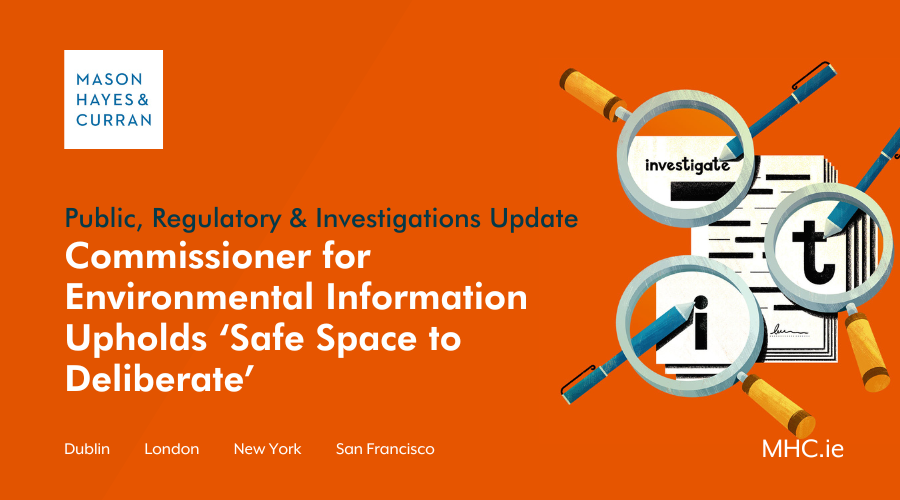Commissioner for Environmental Information Upholds ‘Safe Space to Deliberate’

The Commissioner for Environmental Information (CEI) has recently upheld arguments by a public authority in refusing disclosure of sensitive internal discussion documents under the Access to Information on the Environment Regulations.
The CEI accepted ESB’s submissions that certain information should not be disclosed under the Regulations. The restricted information included details on proposed strategies, policies and thinking related to electricity-line alterations and placement. The CEI determined that the matter fell within the “internal communications” exception. We explore the decision.
What you need to know
- The European Communities (Access to Information on the Environment) Regulations 2007 (AIER) provide a right of access to environmental information held by, or for, public authorities.
- Under Article 9(2)(d) of the AIER, a public authority may refuse to make requested environmental information available where the request “concerns internal communications”.
- All grounds for refusal under the AIER are to be interpreted restrictively, and requests should be considered individually. Even if information may be exempted, consideration must be given to the public interest in disclosing the information. The interest served by withholding the information must be weighed against that public interest.
- The CEI recently had to consider documents withheld by the ESB. These documents discussed business strategies and proposed policies and approaches to strategic matters concerning electricity-line alterations and placement.
- The CEI accepted that the contents qualified as exempt “internal communications.” These documents had circulated only within ESB. On the date of the access request, they had not left ESB’s “internal sphere.”
- The CEI noted that the purpose of the “internal communications” exception was that public authorities should have the “necessary space to think in private”.
- The CEI considered whether disclosure of the information at issue “could specifically and actually undermine” the private thinking space in the particular circumstances of this case, and accepted ESB’s submission that it could.
Introduction
The AIER provide a right of access to environmental information held by, or for, public authorities.
A public authority may refuse to make requested environmental information available where the request “concerns internal communications”[1].
All grounds for refusal under the AIER are to be interpreted restrictively, and requests considered individually[2]. Even if information may be excepted, regard must be had to the public interest served by disclosure, and the interest served by withholding must be weighed against that public interest.
In Freeman[3], the CEI had to consider documents withheld by the ESB. These documents discussed business strategies and proposed policies and approaches to strategic matters concerning electricity-line alterations and placement.
The CEI found that the ESB documents contained sensitive information. Some of these documents dated back to 1971 and 1985. The documents included internal discussion and debate on the application of costs and charges in specific circumstances. The documents also contained opinions on approaches to compensation claims and litigation concerning electricity-line placements.
The CEI noted that Article 4(1)(e) of the AIE Directive (which Article 9(2)(d) transposes) was designed to acknowledge “that public authorities should have the necessary space to think in private” (see Proposal for a Directive of the European Parliament and of the Council on public access to environmental information /* COM/2000/0402 final - COD 2000/0169*/).
In referring to that Proposal, the Court of Justice of the European Union (CJEU) in Land Baden-Württemberg v DR explained the purpose of the exception for internal communications. It stated that, similar to the exception for material in progress or unfinished documents, this rule exists to protect the space public authorities need for internal discussions and reflection.
The CEI also noted that the concept of “internal communications” was not defined in the legislation. The CEI referred to Land Baden-Württemberg v DR, which clarified that “internal communications” must be interpreted as meaning “information which circulates within a public authority and which, on the date of the request for access, has not left that authority’s internal sphere…”.
In addition, the CEI noted that the CJEU in Land Baden-Württemberg had emphasised that general assertions were insufficient to justify withholding “internal communications”. Once information was classified as such, further justification was required. It also had to be demonstrated how disclosure of the information at issue could specifically and actually undermine the private thinking space in the particular circumstances of a given case.
Internal communications
The CEI found that all of the withheld information in this case consisted of communications to the Chief Executive Officer or the Board of ESB. These communications discussed business strategies and proposed policies/approaches to certain business matters. The information had not been shared outside of ESB.
The CEI found that each of the records at issue met the definition of “internal communications” set out by the CJEU in Land Baden-Württemberg.
Specific and actual undermining of private thinking space
ESB’s central argument was that disclosing the requested information would negatively impact the free and frank exchange of views within organisation. It also claimed that disclosure would hinder its ability to conduct similarly effective and desirable internal communications in the future.
Disclosure could also limit the organisation’s ability to freely debate the best approach to handling individual cases internally.
The ESB argued that nothing in the AIE Regulations prevented a public authority from maintaining the confidentiality of its past or present thinking. It stated that this protected thinking space included strategies for negotiating, reaching agreements, arbitrating, or conducting litigation.
The ESB also argued that disclosing the records could reasonably be expected or foreseen to result in a less-than-ideal level of, or decline in, internal communication within the organisation. It stated that employees might be reluctant to engage in these communications owing to the possibility of their future disclosure. It submitted that this went to the heart of the internal communications exception, which, as a matter of public interest, was designed to afford a private thinking space. In ESB’s view, the AIER afforded this space because assuring public authorities and their personnel that these spaces would be protected, except where identified countervailing public interests arose:
“serve[d] to foster open, full, free and frank internal discussion, which in turn serves to ensure important internal openness and transparency – thus leading to optimal decision-making, management and function-performance”.
Against that background, and having reviewed each of the records concerned, the CEI was satisfied that disclosure of the information “would adversely impact ESB’s private thinking space”.
The public interest
When considering the final aspect—the public interest—and whether the benefits of withholding the information were outweighed by the need for disclosure, the CEI acknowledged the public interest in accessing the internal communications. Releasing the information would enhance transparency around decisions made by the ESB on transmission-line alterations and placement.
However, the CEI noted that the information did not represent formal policies or procedures of the organisaton. Instead, it reflected strategies and approaches that guided internal discussions on proposed policies.
Although disclosing the internal communications would serve the public interest by promoting transparency on transmission-line alterations and placement, the CEI also acknowledged the need for public authorities to have a protected space for developing ideas, debating issues, and making decisions without external scrutiny. It determined that this need applied to the information in this case.
The CEI considered that the ESB should be able to maintain the confidentiality of its thinking in these matters, be that “past or present” thinking, and, for example, “vis-à-vis how to deal with those with whom it may have to negotiate and seek to reach agreement and/or arbitrate or conduct litigation”.
In this case, the CEI considered that the ‘safe space’ arguments made by the ESB were:
“weighty factors in favour of maintaining the exception, as the freedom to formulate business strategies and approaches without fear that they would be disclosed into the public domain at a later date [was] deemed necessary by the ESB for effective business operations”.
The CEI concluded that, in this case, the public interest favoured maintaining the “internal communications” exception and withholding disclosure of the ESB’s internal communications. He also considered the availability of publicly accessible material related to the subject matter, which helped address the general public interest in ESB’s transparency. For example, the CEI noted that the ESB and the Irish Farmers’ Association had published a Code of Practice on the survey, construction, and maintenance of overhead lines. This document provided guidelines for various activities and included schedules of compensation payable to landowners in certain circumstances.
Conclusion
The AIER provide an extensive right to be provided with environmental information held by public authorities, subject to limited exceptions.
In Article 9(2)(d), where a request relates to “internal communications” of an authority, the AIER recognise the need for the authority to have the necessary space to think in private, and to develop ideas, debate issues and reach decisions away from external scrutiny.
A public authority will successfully invoke this exception where it can establish:
- That the requested environmental information concerns internal communications
- That the communications have not left its internal sphere, and have not been disclosed publicly
- How disclosure of that information could specifically and actually undermine the authority’s private thinking space, and
- Why the interests protected by the “internal communications” exception in the particular case are not outweighed by the public interest in the disclosure of the environmental information concerned.
General claims of harm or disruption to a private thinking space are not enough. Specific details are required to show how this harm could reasonably be expected to occur.
The latter will also help to inform the public interest weighing process. The weightier and more specific the actual considerations and interests protected by the thinking space in a particular case are, the better the chance that the public interest in disclosure of the information will not outweigh those interests.
The exception may still apply in a particular case if the public interest does not outweigh it. Relevant information promoting transparency may already be available. The exception could also apply if the environmental information in the internal communications is not particularly significant or consequential.
For more information and expert advice, please contact a member of our Public, Regulatory & Investigations team.
People also ask
What does Article 9(2)(d) of the Access to Information on the Environment Regulations 2007 provide for? |
Article 9(2)(d) of the Access to Information on the Environment Regulations 2007 provides for an exception to the requirement on public authorities under the Regulations to make available requested environmental information if the request “concerns internal communications of public authorities, taking into account the public interest served by the disclosure”. |
What is the purpose of the exception in Article 9(2)(d) of the Access to Information on the Environment Regulations 2007, concerning “internal communications of public authorities”? |
The purpose of the exception in Article 9(2)(d) of the Access to Information on the Environment Regulations 2007, concerning “internal communications of public authorities”, was stated by the CJEU in Land Baden-Wurtemburg v DR to have been intended to “meet the need of public authorities to have a protected space in order to engage in reflection and to pursue internal discussions”. |
What is required to invoke the exception in Article 9(2)(d) of the Access to Information on the Environment Regulations 2007 successfully? |
A public authority will successfully invoke this exception where it can establish
|
The content of this article is provided for information purposes only and does not constitute legal or other advice.
[1] Article 9(2)(d) of the AIER
[2] Articles 10(3) and (4) of the AIER
[3] Thomas Freeman and the Electricity Supply Board (Case: OCE-136305-G7D8R3
Share this:



